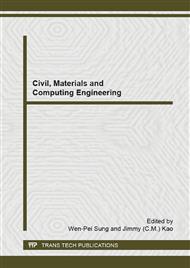p.327
p.333
p.338
p.342
p.348
p.354
p.359
p.364
p.368
A Design Process for a Foldable Container Structure Using a Finite Element Analysis
Abstract:
This study is concerned with a design process for a foldable container structure using a finite element analysis. A foldable container structure consists of frames, panels and hinge systems. The main structure of a foldable container carries all the loads while a hinge system is designed to provide its foldability. In this work, finite element structural analyses for the main foldable container structure are carried out based on the ISO standard regulation, whose results are then taken for the design of a hinge system. The finite element analysis with two types of hinge systems are also performed. It is found out that the main structure of a standard 20ft container could be used for the foldable container with the same capacity if the corner edge in the side assembly is strengthened. It is also concluded that the hinge systems proposed in this work could be successfully used in a foldable 20ft container.
Info:
Periodical:
Pages:
348-353
Citation:
Online since:
December 2014
Authors:
Price:
Сopyright:
© 2015 Trans Tech Publications Ltd. All Rights Reserved
Share:
Citation:


